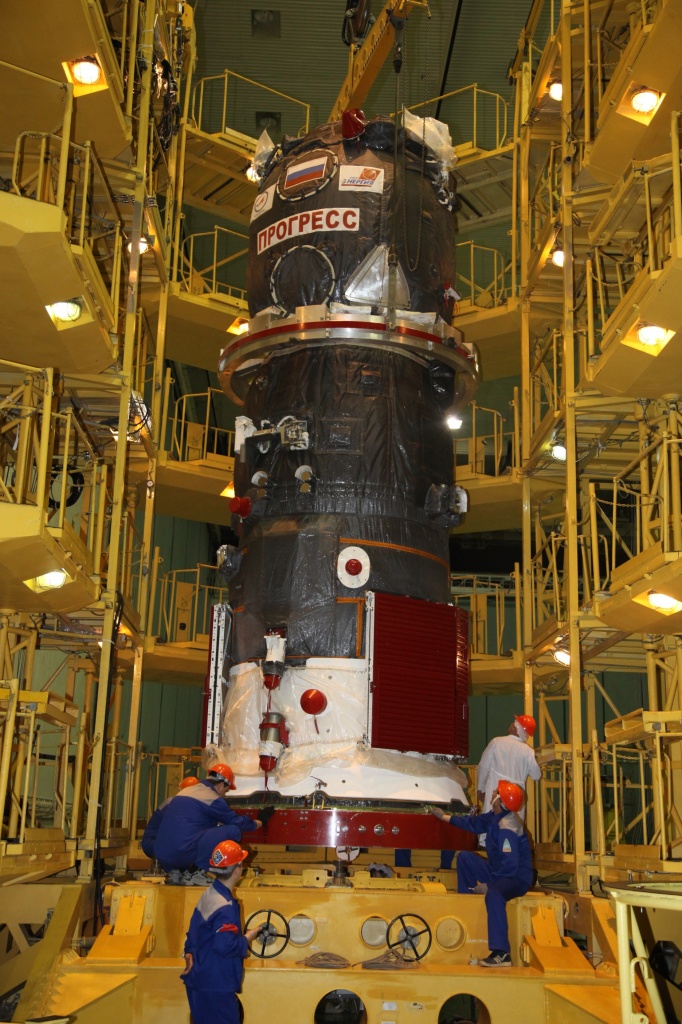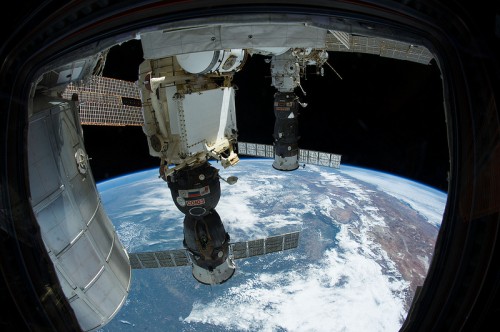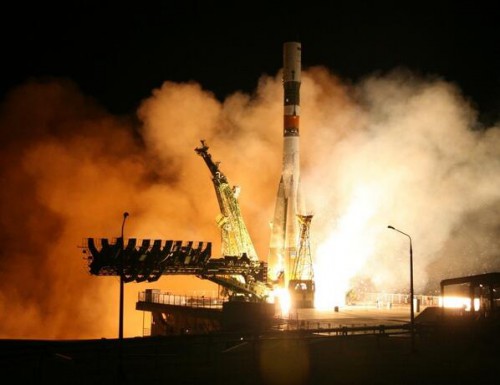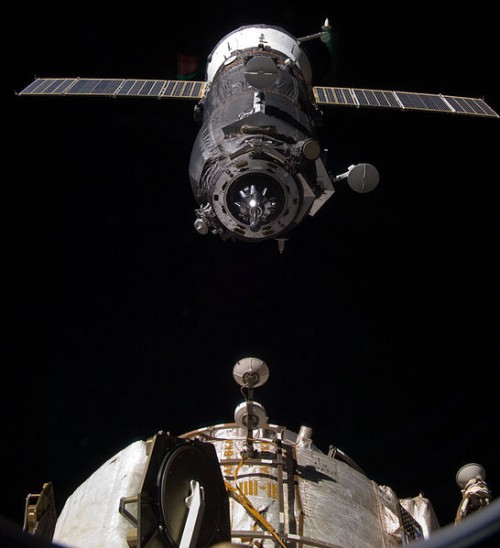
Following a comparatively brief two months docked at the International Space Station (ISS), Russia’s Progress M-22M cargo craft—also known as “Progress 54P” in ISS Program-speak—successfully separated from the orbital outpost at 9:58 a.m. EDT yesterday (Monday). It will spend the next 11 days undergoing tests as part of the ongoing “Radar Progress” experiment, which will examine the density, size, and reflectivity of the ionospheric environment surrounding the spacecraft, before it is deorbited on 18 April. In the meantime, its successor, Progress M-23M, encapsulated within the payload shroud of a mammoth Soyuz-U booster, was rolled out to its launch pad at Baikonur Cosmodrome in Kazakhstan Monday, preparatory to its own launch Wednesday.
Launched toward the ISS on 5 February, Progress M-22M followed a now-customary “fast rendezvous” profile and docked at the Earth-facing (or “nadir”) port of the station’s Zvezda service module a mere six hours, and four orbits, into its mission. The spacecraft delivered about 5,600 pounds (2,540 kg) of foodstuffs, water, propellant, equipment, and supplies to the incumbent crew. According to Spaceflight101, it supported a series of propulsive maneuvers and a Debris Avoidance Maneuver (DAM) on 17 March to create a safe distance from a fragment of a Russian weather satellite. In its final days, Progress M-22M was loaded with unneeded gear and trash and Expedition 39’s Russian cosmonauts Mikhail Tyurin, Aleksandr Skvortsov, and Oleg Artemyev activated its systems, removed sensors and air ducts, and prepared it for departure. Its docking mechanism was installed on Sunday and hatches between the spacecraft and Pirs—which is utilized as both a docking port and as a EVA airlock for the Russian Segment (RS)—were closed.
Early Monday morning the spacecraft was electrically disconnected from the ISS. “Shortly before undocking,” noted Spaceflight101, “the docking mechanism was powered up and the undocking command was issued 90 seconds before separation, initiating the opening of hooks and latches on the Progress.” The two space vehicles parted company precisely on time at 9:58 a.m. EDT, although it will be several more days before Progress M-22M is directed to perform a final maneuver to execute a destructive re-entry into Earth’s upper atmosphere. It will shortly undertake the five-day “Radar Progress” experiment, which has been supported by several previous missions, dating back to 2010, and seeks to understand the effect of thruster firings upon the local ionospheric plasma environment. As the spacecraft performs these firings, it will be tracked by the Institute of Solar-Terrestrial Physics Siberian Branch of the Russian Academy of Sciences in Irkutsk. Upon completion of the experiment, Progress M-22M will be deorbited over the Pacific Ocean on 18 April.

With the departure of this most recent visiting vehicle, the next occupant of the ISS Pirs port was rolled out to its launch pad at Baikonur Cosmodrome yesterday (Monday). Progress M-23M was fueled in the Spacecraft Assembly and Testing Facility last week and encapsulated within the payload shroud of its giant Soyuz-U booster on Thursday, 3 April. Following technical management meetings and the customary Russian Government Commission, authorization was granted to transfer the stack out to the pad. Early Monday, the Soyuz-U—a direct descendent of Chief Designer Sergei Korolev’s R-7 missile—and its precious cargo were rolled horizontally out to Baikonur’s Site 1/5 and raised to a vertical configuration. Electrical and propellant umbilicals were connected as technicians prepared for the process of battery charging and fueling operations.
Liftoff is presently scheduled for 9:26 p.m. local time (11:26 a.m. EDT) Wednesday, after which Progress M-23M will follow the now-standard six-hour, four-orbit “fast rendezvous” regime. Assuming all goes well, it will dock at the Pirs module a little before 5:20 p.m. EDT, delivering about 6,000 pounds (2,700 kg) of foodstuffs, water, propellant, equipment, and other supplies for the Expedition 39 crew. The ISS is currently staffed by Commander Koichi Wakata of the Japan Aerospace Exploration Agency (JAXA), together with Russian cosmonauts Mikhail Tyurin, Aleksandr Skvortsov, and Oleg Artemyev and NASA astronauts Rick Mastracchio and Steve Swanson. Of this group, Wakata, Tyurin, and Mastracchio have been in orbit since early November 2013, whilst Skvortsov, Artemyev, and Swanson arrived two weeks ago aboard Soyuz TMA-12M.
The process of loading liquid oxygen and rocket-grade kerosene (known as “RP-1”) aboard the Soyuz-U booster is expected to commence about five hours before tomorrow’s liftoff, after which it will transition into a topping mode, whereby all cryogenic boil-off of propellants will be rapidly replenished. This will ensure that the liquid oxygen tanks are maintained at Flight Ready levels, ahead of the ignition of the Soyuz-U’s single RD-118 first-stage engine and the RD-117 engines of its four tapering strap-on boosters. Internal avionics will be initiated, and the on-board flight recorders will be spooled-up to monitor the vehicle’s myriad systems. At T-10 seconds, the turbopumps on the core and strap-on boosters will come to life. After confirmation that the engines are all running at full power, the fueling tower will be retracted and Progress M-23M will roar into the darkened sky, turning night into day across the desolate steppe of Kazakhstan.
Rising rapidly, the vehicle will pass 1,100 mph (1,770 km/h) within a minute of liftoff, during which time the maximum amount of aerodynamic stress (known as “Max Q”) is expected to impact the vehicle’s airframe. At T+118 seconds, at an altitude of about 28 miles (45 km), the four strap-on boosters will exhaust their liquid oxygen and RP-1 and will be jettisoned, leaving the central core and its single engine to continue the ascent. By two minutes into the flight, the rocket will be traveling at over 3,350 mph (5,390 km/h). The payload shroud and escape tower will be jettisoned shortly afterward, and, some four minutes and 50 seconds after leaving Baikonur, the core stage will separate at an altitude of 105 miles (170 km) and the RD-0110 engine of the third stage will ignite to boost Progress M-23M to a velocity in excess of 13,420 mph (21,600 km/h). By the point of third stage separation, about nine minutes into the flight, the vehicle will be in space.

Separation of Progress M-23M from the final stage of the launch vehicle is expected to take place into a target orbit of approximately 120 x 152 miles (193 x 245 km), inclined 51.6 degrees to the equator. Shortly afterward, the process of unfurling its solar arrays and Kurs (“Course”) rendezvous and navigation appendages will get underway.
The arrival of Progress M-22M at the ISS on Wednesday evening will mark the first unpiloted visiting vehicle of Expedition 39, which began last month when outgoing Expedition 38 skipper Oleg Kotov handed command of the space station over to Koichi Wakata. The traffic of visiting vehicles is becoming somewhat congested, particularly in the aftermath of delays to the launch of SpaceX’s third dedicated Dragon cargo mission (SpX-3), which has been postponed until no earlier than 14 April. Since Dragon will remain berthed at the nadir port of the station’s Harmony node for about a month, the launch of the next visiting vehicle—Orbital Sciences Corp.’s ORB-2 Cygnus cargo mission, which will also require the Harmony nadir port—will likely be postponed by at least a week beyond its original 6 May target date.
With the arrival of Progress M-22M at the ISS, no fewer than two Progresses will be in attendance at the multi-national laboratory. Another craft, Progress M-21M, was launched in November 2013 and is presently docked at the aft longitudinal port of the Zvezda module, from which it executed periodic reboosts of the space station’s orbital altitude in December and March. It is scheduled to undock from Zvezda on 23 April for autonomous testing of the new Kurs-NA navigation system, before redocking two days later. Progress M-21M will then remain docked until mid-June, whereupon it will depart the ISS for the final time and be deorbited in the upper atmosphere.
Progress has a storied history. Its development began in 1973 in response to the anticipated problem of resupplying and refueling the Soviet Union’s Salyut 6 space station, whose cosmonauts went on to spend more than six months at a time in orbit. Modeled closely on the Soyuz spacecraft, its interior was redesigned to house foodstuffs, water, experiments, and fuel for the station’s maneuvering thrusters. Since its maiden voyage, Progress has seen many changes, but its role has remained largely unchanged … and the numbers speak for themselves. Between its first launch in January 1978 and today’s flight, no fewer than 144 Progresses have roared aloft. Only one has failed to reach its destination: the unlucky Progress M-12M in August 2011, whose launch vehicle suffered an engine malfunction and re-entered the atmosphere over the Altai region.

Writing in 1998, astronaut Jerry Linenger—one of the handful of U.S. astronauts to reside aboard Russia’s Mir space station—recounted the sheer joy of receiving a shoebox full of goodies from his wife and children: “Once found, and munching on fresh apples that had also arrived in the Progress,” he described in his memoir, Off the Planet, “we individually retreated from our work and sneaked off to private sections of the space station, eager to peruse the box’s contents.” Fellow astronaut John Blaha once described similar excitement: “Once we found our packages,” he wrote, “it was like Christmas and your birthday, all rolled together, when you are five years old. We really had a lot of fun reading mail, laughing, opening presents, eating fresh tomatoes and cheese.” In more recent times, ISS crew members have done much the same. In February 2008, Peggy Whitson, commander of Expedition 16, remembered crewmate Dan Tani calling one Progress “the onion express,” as the latest delivery of letters from home and fresh foodstuffs arrived.
In their book Soyuz: A Universal Spacecraft, David Shayler and the late Rex Hall speculated that the term “Progress” may have originated from the implication of having made significant progress in space station operations, although the precise heritage of the name remains unclear. What is clear, though, is that aside from the technical and functional role of Progress over the decades, it has provided an indispensable psychological crutch for dozens of cosmonauts and astronauts—a crutch which has enabled them to overcome the profound isolation of the strange microgravity environment, far from family and friends.
Want to keep up-to-date with all things space? Be sure to “Like” AmericaSpace on Facebook and follow us on Twitter: @AmericaSpace
Missions » Progress » M-23M »



The sleep room is very important place in home for each human, even if we consider that it is not significant how it appears. It is the place where we take a rest after the hard day of job. A bedroom is a space that should give us also a great joy, because we can relax here and give the rest to our bodies, which it certainly deserves. This is why it is so significant to design a bedroom, in the way which we should feel very great. As a pretty ornament for sleep rooms we offer wall murals, which you are able to find in our shop. But, if you are interested in picture wallpaper murals, then you’re in the right space, because in our shop you will find the beautiful wallpapers for each place.